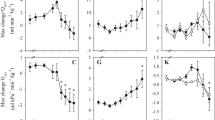Abstract
In several ectotherms, including all members of the Osteichthyes studied so far, the spleen is capable of storing and releasing erythrocytes according to the animal's respiratory needs. The tropical cave cyprinid Phreatichthys andruzzii uses its liver rather than the spleen as the site of accumulation in the respiratory compensation process, like the amphibian Rana esculenta. The reversible process of erythrocyte accumulation in the liver is very evident in animals anaesthetized with chlorobutanol; MS-222, an anaesthetic widely used in lower vertebrates alters all the haematological parameters and is not suitable for studies on blood and respiration. The hepatic respiratory compensation mechanism is as efficient as the splenic one: in animals kept at 18 °C for 24 h the mean liver weight percentage was 70% higher than in specimens kept at 28 °C (2.43% of the body weight compared to 1.39%, in groups of six specimens) while mean red blood cell counts fell from 2.49 to 1.60 · 1012 per l, in agreement with the haematocrit value and haemoglobin concentration; mean corpuscular volume remained constant (at about 177 fl).
Similar content being viewed by others
Author information
Authors and Affiliations
Additional information
Accepted: 15 April 1997
Rights and permissions
About this article
Cite this article
Frangioni, G., Berti, R. & Borgioli, G. Hepatic respiratory compensation and haematological changes in the cave cyprinid, Phreatichthys andruzzii. J Comp Physiol B 167, 461–467 (1997). https://doi.org/10.1007/s003600050097
Issue Date:
DOI: https://doi.org/10.1007/s003600050097



